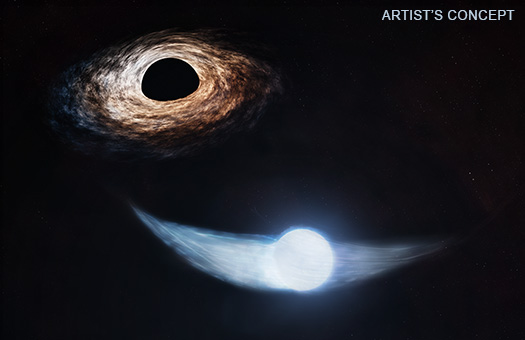Quasars & Active Galaxies
Chandra Reveals an Extremely Fast Accreting Black Hole in the Early Universe
We are happy to welcome Luca Ighina as a guest blogger. Luca is a postdoctoral fellow at the Center for Astrophysics | Harvard and Smithsonian and the first author of a paper that is the subject of our latest Chandra press release. In his research he studies the most distant supermassive black holes with a focus on those able to expel part of the material they are pulling inwards in the form of jets moving at close to the speed of light. To this end he uses the most sensitive telescopes around the world covering the entire electromagnetic spectrum, from the radio to the optical-near-infrared to the X-ray band. He received his PhD from the Insubria University (Como, Italy), where he mainly worked at the INAF institute in Milano-Brera (Italy), along with a one-year visit to the ICRAR institute for radio astronomy in Perth (Western Australia).
How do supermassive black holes grow in the early Universe?
Most galaxies observed in the Universe host a supermassive black hole at their center. Some of them, called active galactic nuclei (AGN) or quasars, grow in mass as surrounding material falls inwards through a process called accretion. Astronomers have found some extreme examples of quasars that can reach masses of several billion times that of the Sun, only one billion years after the Big Bang. Understanding how these black holes formed and grew so rapidly remains one of the major open questions in modern astrophysics.
NASA Telescopes Pinpoint Free-Roaming Massive Black Hole
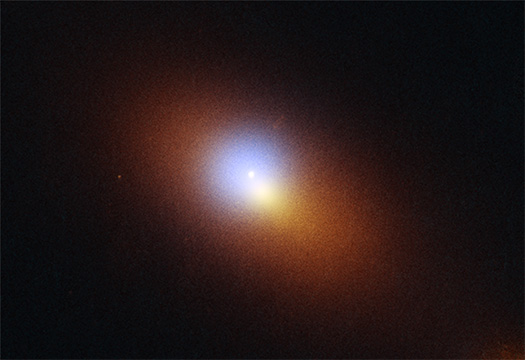
Tidal Disruption Event AT2024tvd
Credit: X-ray: NASA/CXC/SAO/Univ. of California, Berkeley/Y. Yao et al.; Optical/UV: NASA/ESA/STScI/HST; Image Processing: NASA/STScI/J. DePasquale
Astronomers have discovered a black hole has torn apart a star (a phenomenon called a tidal disruption event, or TDE) in a surprising location, as described in this press release. This event occurred about 2,600 light-years away from the center of the black hole’s host galaxy, indicating the presence of a second large black hole. Most TDEs have been detected at the centers of galaxies where supermassive black holes are usually found.
A TDE happens when an infalling star is stretched or “spaghettified” by a black hole’s immense gravitational tidal forces. The shredded stellar remnants are pulled into a circular orbit around the black hole. This generates shocks and outflows with high temperatures that can be seen in ultraviolet and visible light. X-rays are produced when material from the destroyed star falls toward the black hole and is heated to millions of degrees.
Chandra Sees Black Hole Jet Stumble Into Something in the Dark
Even matter ejected by black holes can run into objects in the dark. Using NASA’s Chandra X-ray Observatory, astronomers have found an unusual mark from a giant black hole’s powerful jet striking an unidentified object in its path.
The discovery was made in a galaxy called Centaurus A (Cen A), located about 12 million light-years from Earth. Astronomers have long studied Cen A because it has a supermassive black hole in its center sending out spectacular jets that stretch out across the entire galaxy. The black hole launches this jet of high-energy particles not from inside the black hole, but from intense gravitational and magnetic fields around it.
Black Hole Destroys Star, Goes After Another, NASA Missions Find
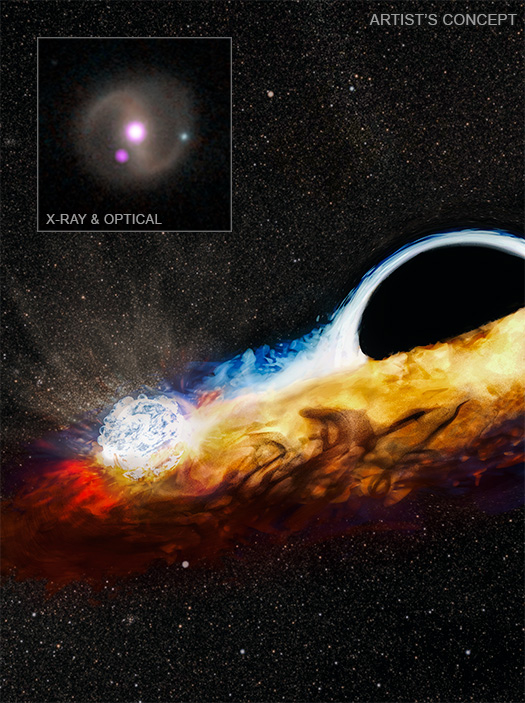
AT2019qiz
Credit: X-ray: NASA/CXC/Queen's Univ. Belfast/M. Nicholl et al.; Optical/IR: PanSTARRS, NSF/Legacy Survey/SDSS; Illustration: Soheb Mandhai / The Astro Phoenix; Image Processing: NASA/CXC/SAO/N. Wolk
NASA’s Chandra X-ray Observatory and other telescopes have identified a supermassive black hole that has torn apart one star and is now using that stellar wreckage to pummel another star or smaller black hole, as described in our latest press release. This research helps connect two cosmic mysteries and provides information about the environment around some of the bigger types of black holes.
This artist’s illustration shows a disk of material (red, orange, and yellow) that was created after a supermassive black hole (depicted on the right) tore apart a star through intense tidal forces. Over the course of a few years, this disk expanded outward until it intersected with another object — either a star or a small black hole — that is also in orbit around the giant black hole. Each time this object crashes into the disk, it sends out a burst of X-rays detected by Chandra. The inset shows Chandra data (purple) and an optical image of the source from Pan-STARRS (red, green, and blue).
Chandra Teams Up Again With Astrophotographers
Messier 106 (M106), also known as NGC 4258, is a spiral galaxy – like our own Milky Way -- located in the constellation Canes Venatici. It lies at a distance of roughly 23 million light-years and spans some 135,000 light-years in diameter.
This galaxy is famous, however, for something that our Galaxy doesn’t have – two extra spiral arms that glow in X-ray, optical, and radio light. These features, called anomalous arms, are not aligned with the plane of the galaxy, but instead intersect with it. The X-ray image from Chandra reveals huge bubbles of hot gas above and below the plane of the galaxy. These bubbles indicate that much of the gas that was originally in the disk of the galaxy has been heated to millions of degrees and ejected into the outer regions by the jets from a supermassive black hole at the galaxy’s core.
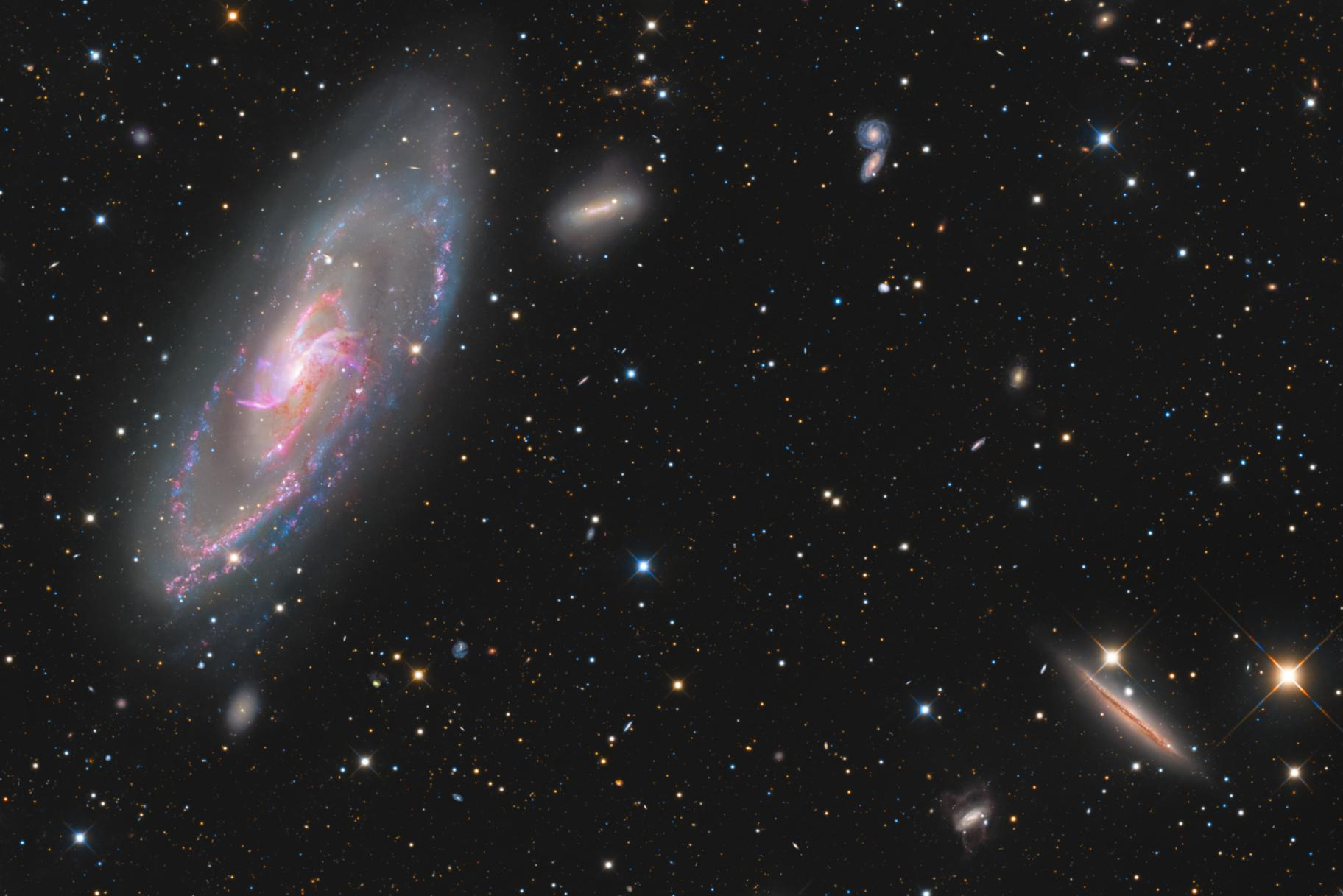
Credit: Optical: Deep Sky Collective; Chandra X-ray (purple): NASA/CXC/SAO;
VLA Radio (yellow): NSF/NRAO/VLA; Spitzer IR (Red): NASA/JPL-Caltech
It's not only space-based X-ray telescopes like Chandra, however, that have looked at M106. Excellent work has been done from the ground including by amateur astrophotographers including a group called the Deep Sky Collective (DSC). The DSC, founded by Tim Schaeffer in 2023, aims to use the group’s telescopes in a concerted way to explore some of the faintest and most difficult target in the sky in great detail.
How do Supermassive Black Holes Get Super Massive?
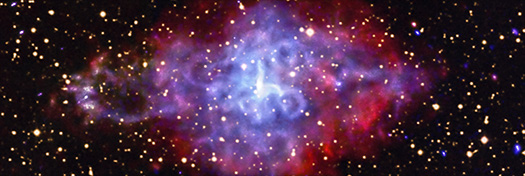
3C 58
Credit: X-ray: NASA/CXC/ICE-CSIC/A. Marino et al.; Optical: SDSS; Image Processing: NASA/CXC/SAO/J. Major
The supernova remnant 3C 58 contains a spinning neutron star, known as PSR J0205+6449, at its center. Astronomers studied this neutron star and others like it to probe the nature of matter inside these very dense objects. A new study, made using NASA’s Chandra X-ray Observatory and ESA’s XMM-Newton, reveals that the interiors of neutron stars may contain a type of ultra-dense matter not found anywhere else in the Universe.
In this image of 3C 58, low-energy X-rays are colored red, medium-energy X-rays are green, and the high-energy band of X-rays is shown in blue. The X-ray data have been combined with an optical image in yellow from the Digitized Sky Survey. The Chandra data show that the rapidly rotating neutron star (also known as a “pulsar”) at the center is surrounded by a torus of X-ray emission and a jet that extends for several light-years. The optical data shows stars in the field.
Unexpectedly Calm and Remote Galaxy Cluster Discovered
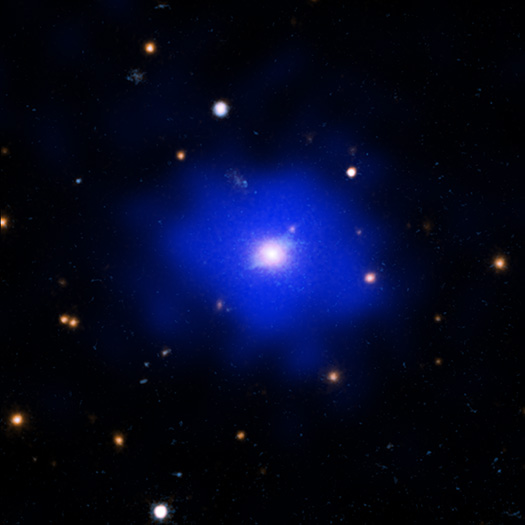
Credit: X-ray: NASA/CXC/MIT/M. Calzadilla; UV/Optical/Near-IR/IR: NASA/STScI/HST; Image processing: N. Wolk
The discovery of the most distant galaxy cluster with a specific important trait – as described in our press release – is providing insight into how these gigantic structures formed and why the universe looks like it does in the present day.
'H' is for Hot and Huge in Chandra Image
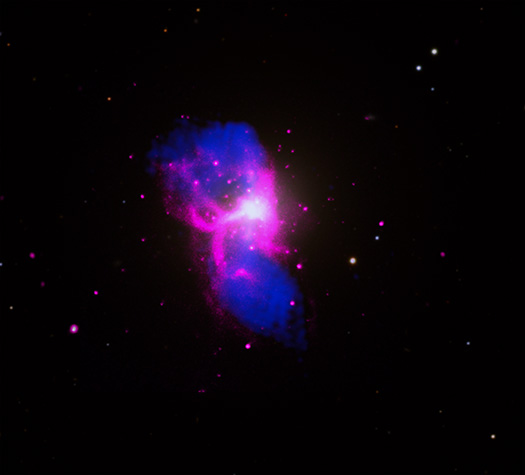
M84
Credit: X-ray: NASA/CXC/Princeton Univ/C. Bambic et al.; Optical: SDSS; Radio: NSF/NRAO/VLA/ESO; Image processing: NASA/CXC/SAO/N.Wolk
With a single letter seemingly etched in the X-ray glow around it, a giant black hole at the center of a massive elliptical galaxy is making a mark on its surroundings.
This “H”-shaped structure is found in a detailed new X-ray map of the multimillion-degree gas around the galaxy Messier 84 (M84).
As gas is captured by the gravitational force of the black hole, some of it will fall into the abyss, never to be seen again. Some of the gas, however, avoids this fate and instead gets blasted away from the black hole in the form of jets of particles. These jets can push out cavities, in the hot gas surrounding the black hole. Given the orientation of the jets to Earth and the profile of the hot gas, the cavities in M84 form what appears to resemble the letter “H.” The H-shaped structure in the gas is an example of pareidolia, which is when people see familiar shapes or patterns in random data. Pareidolia can occur in all kinds of data from clouds to rocks and astronomical images.
Centaurus A Shines in New Image from NASA's Chandra and IXPE
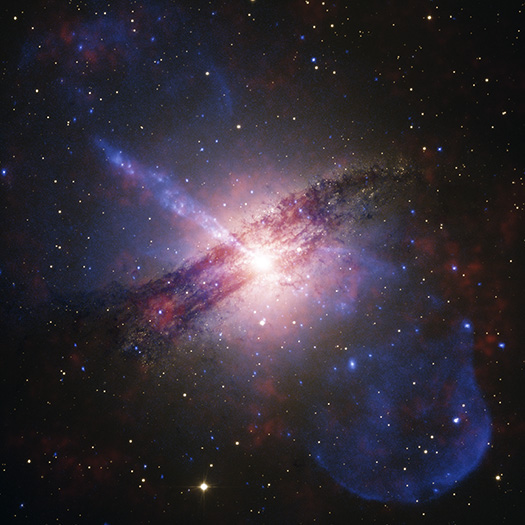
Centaurus A
Credit: X-ray: (IXPE): NASA/MSFC/IXPE/S. Ehlert et al.; (Chandra): NASA/CXC/SAO; Optical: ESO/WFI; Image processing: NASA/CXC/SAO/J.Schmidt
The galaxy Centaurus A (Cen A) shines bright in this image combining data from multiple observatories. In the center of this galaxy is a supermassive black hole feeding off the gas and dust encircling it, and large jets of high-energy particles and other material spewing out. The jet shown at the upper left of this image extends for about 13,000 light-years away from the black hole. Also visible is a dust lane, wrapping around the middle of the galaxy, which may have resulted from a collision with a smaller galaxy millions of years ago.
Colors in this image have been chosen to reflect the sources of data. Blue shows X-ray light captured by NASA’s Chandra X-ray Observatory, orange represents X-rays detected by NASA’s Imaging X-ray Polarimetry Explorer (IXPE) satellite, and optical light seen by the European Southern Observatory in Chile is colored white and gray.



